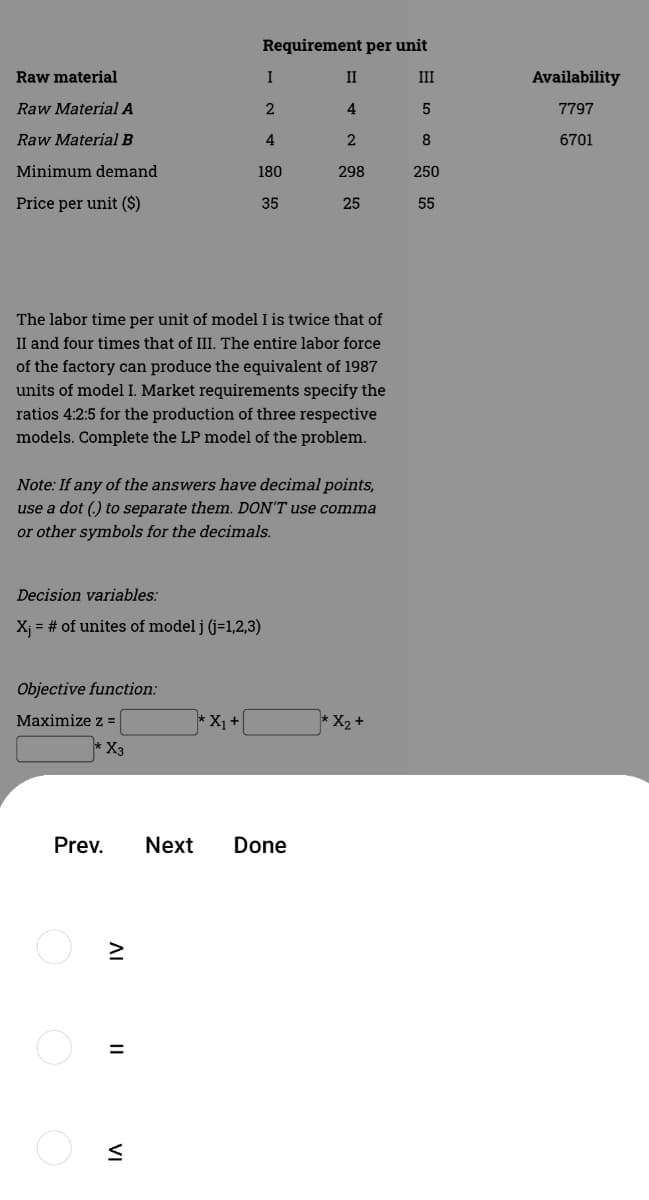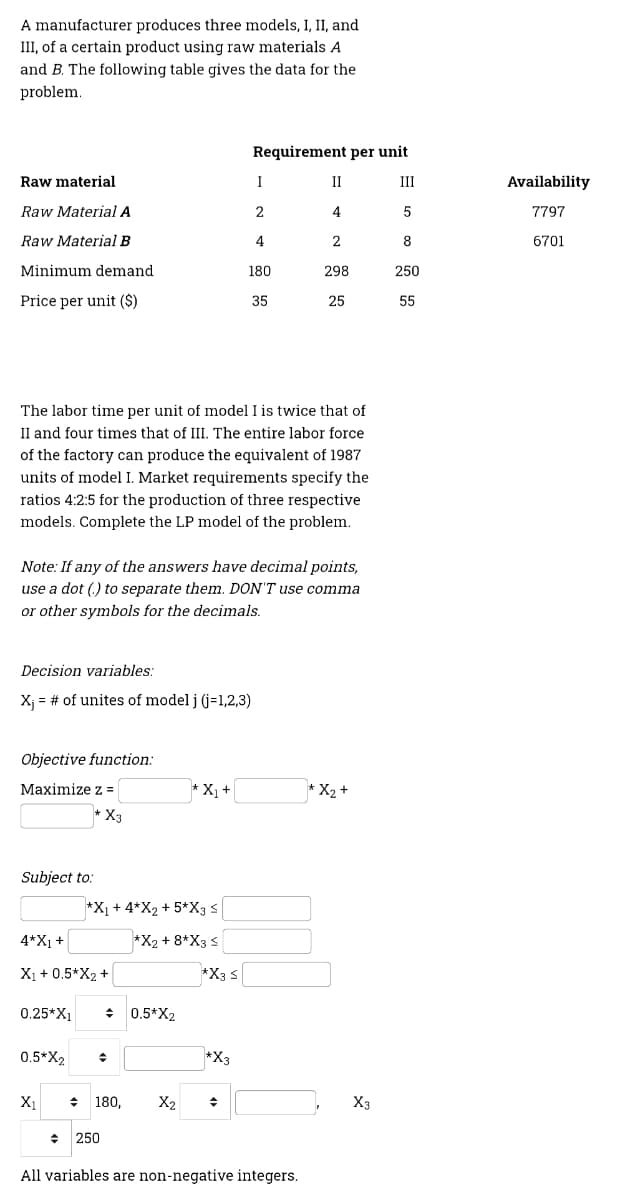A manufacturer produces three models, I, II, and III, of a certain product using raw materials A and B. The following table gives the data for the problem. Requirement per unit Raw material I II III Availability Raw Material A 2 4 7797 Raw Material B 4 8 6701 Minimum demand 180 298 250 Price per unit ($) 35 25 55 The labor time per unit of model I is twice that of II and four times that of III. The entire labor force of the factory can produce the equivalent of 1987 units of model I. Market requirements specify the ratios 4:2:5 for the production of three respective models. Complete the LP model of the problem. Note: If any of the answers have decimal points, use a dot () to separate them. DON'T use comma or other symbols for the decimals. Decision variables: X = # of unites of model j (j=1,2,3) Objective function: Maximize z = * X,+ X2+ * X3 Subject to: *X1 + 4*X2 + 5*X3 s 4*X1 + *X2 + 8*X3 s Xị + 0.5*X2 + *X3 s 0.25*X1 : 0.5*X2 0.5*X2 *X3 X1 180, X2 X3 250 All variables are non-negative integers.
A manufacturer produces three models, I, II, and III, of a certain product using raw materials A and B. The following table gives the data for the problem. Requirement per unit Raw material I II III Availability Raw Material A 2 4 7797 Raw Material B 4 8 6701 Minimum demand 180 298 250 Price per unit ($) 35 25 55 The labor time per unit of model I is twice that of II and four times that of III. The entire labor force of the factory can produce the equivalent of 1987 units of model I. Market requirements specify the ratios 4:2:5 for the production of three respective models. Complete the LP model of the problem. Note: If any of the answers have decimal points, use a dot () to separate them. DON'T use comma or other symbols for the decimals. Decision variables: X = # of unites of model j (j=1,2,3) Objective function: Maximize z = * X,+ X2+ * X3 Subject to: *X1 + 4*X2 + 5*X3 s 4*X1 + *X2 + 8*X3 s Xị + 0.5*X2 + *X3 s 0.25*X1 : 0.5*X2 0.5*X2 *X3 X1 180, X2 X3 250 All variables are non-negative integers.
Practical Management Science
6th Edition
ISBN:9781337406659
Author:WINSTON, Wayne L.
Publisher:WINSTON, Wayne L.
Chapter6: Optimization Models With Integer Variables
Section: Chapter Questions
Problem 49P
Related questions
Question
100%
Operations research Optimization

Transcribed Image Text:Requirement per unit
Raw material
I
II
II
Availability
Raw Material A
4
7797
Raw Material B
4
2
8
6701
Minimum demand
180
298
250
Price per unit ($)
35
25
55
The labor time per unit of model I is twice that of
II and four times that of III. The entire labor force
of the factory can produce the equivalent of 1987
units of model I. Market requirements specify the
ratios 4:2:5 for the production of three respective
models. Complete the LP model of the problem.
Note: If any of the answers have decimal points,
use a dot (.) to separate them. DON'T use comma
or other symbols for the decimals.
Decision variables:
X; = # of unites of model j (j=1,2,3)
Objective function:
Maximize z =
*X1+
* X2 +
* X3
Prev.
Next
Done
II
VI

Transcribed Image Text:A manufacturer produces three models, I, II, and
III, of a certain product using raw materials A
and B. The following table gives the data for the
problem.
Requirement per unit
Raw material
I
II
III
Availability
Raw Material A
2
4
5
7797
Raw Material B
4
2
8
6701
Minimum demand
180
298
250
Price per unit ($)
35
25
55
The labor time per unit of model I is twice that of
II and four times that of III. The entire labor force
of the factory can produce the equivalent of 1987
units of model I. Market requirements specify the
ratios 4:2:5 for the production of three respective
models. Complete the LP model of the problem.
Note: If any of the answers have decimal points,
use a dot (.) to separate them. DON'T use comma
or other symbols for the decimals.
Decision variables:
X; = # of unites of model j (j=1,2,3)
Objective function:
Maximize z =
* X1+
* X2+
* X3
Subject to:
*X1 + 4*X2 + 5*X3 s
4*X1 +
*X2 + 8*X3 s
X1 + 0.5*X2 +
*X3 s
0.25*X1
+ 0.5*X2
0.5*X2
*X3
X1
+ 180,
X2
X3
250
All variables are non-negative integers.
Expert Solution
This question has been solved!
Explore an expertly crafted, step-by-step solution for a thorough understanding of key concepts.
This is a popular solution!
Trending now
This is a popular solution!
Step by step
Solved in 3 steps with 1 images

Recommended textbooks for you

Practical Management Science
Operations Management
ISBN:
9781337406659
Author:
WINSTON, Wayne L.
Publisher:
Cengage,

Practical Management Science
Operations Management
ISBN:
9781337406659
Author:
WINSTON, Wayne L.
Publisher:
Cengage,